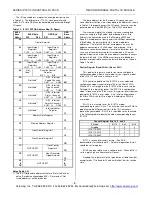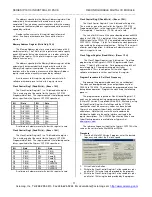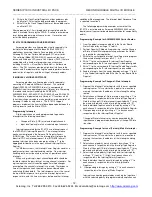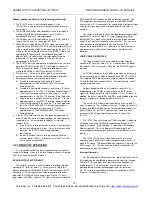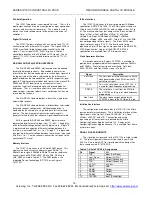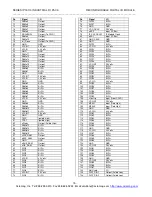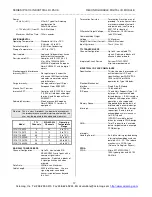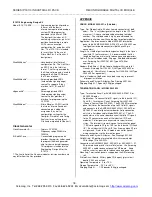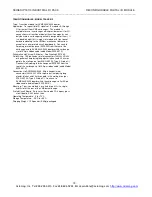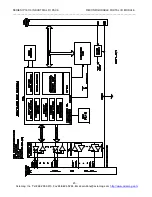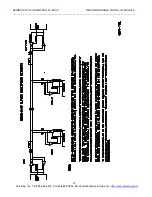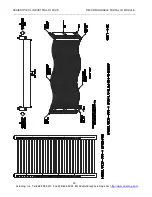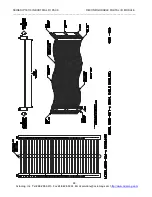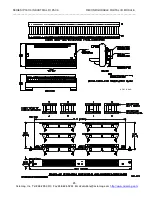
SERIES IP1K110 INDUSTRIAL I/O PACK RECONFIGURABLE DIGITAL I/O MODULE
__________________________________________________________________________________________
- 10 -
Acromag, Inc. Tel:248-295-0310 Fax:248-624-9234 Email:solutions@acromag.com
http://www.acromag.com
interrupt on level. An interrupt will be generated when the input
channel level specified by the Interrupt Polarity Register occurs
(i.e. Low or High level transition interrupt). A “1” bit means the
interrupt will occur when a Change-Of-State (COS) occurs at the
corresponding input channel (i.e. any state transition, low to high
or high to low).
The Interrupt Type Configuration register at the carrier’s base
a offset 0DH is used to control channels 00 through 07.
For example, channel 00 is controlled via data bit-0 as seen in
the table below.
Interrupt Type (COS or H/L) Configuration Register
MSB
LSB
Data
Bit
07
Data
Bit
06
Data
Bit
05
Data
Bit
04
Data
Bit
03
Data
Bit
02
Data
Bit
01
Data
Bit
00
Ch07
Ch06
Ch05
Ch04
Ch03
Ch02
Ch01
Ch00
Channel read or write operations use 8-bit, or 16-bit data
transfers. The upper 8 bits of this register are “Not Used” and will
always read low (0’s) for D16 accesses. Note that interrupts will
not occur unless they are enabled.
All bits are set to “0” following a reset which means that, if
enabled, the inputs will cause interrupts for the levels specified by
the digital input channel Interrupt Polarity Register.
Interrupt Status Registers (Read/Write) - (Base + 0FH)
The Interrupt Status Register reflects the status of each of
the interrupting channels. A “1” bit indicates that an interrupt is
pending for the corresponding channel. A channel that does not
have interrupts enabled will never set its interrupt status flag. A
channel’s interrupt can be cleared by writing a “1” to its bit
position in the Interrupt Status Register (writing a “1” acts as a
reset signal to clear the set state). This is known as the “Release
On Register Access” (RORA) method, as defined in the VME
system architecture specification. However, if the condition which
caused the interrupt to occur remains, the interrupt will be
generated again (unless disabled via the Interrupt Enable
Register). In addition, an interrupt will be generated if any of the
channels enabled for interrupt have an interrupt pending (i.e. one
that has not been cleared). Writing “0” to a bit location has no
effect; that is, a pending interrupt will remain pending.
Note that interrupts are not prioritized via hardware. The
system software must handle interrupt prioritization.
The Interrupt Status register at the carrier’s base a
offset 0FH is used to monitor pending interrupts corresponding to
channels 00 through 07. For example, channel 00 is monitored
via data bit-0 as seen in the table below.
Interrupt Status Register
MSB
LSB
Data
Bit
07
Data
Bit
06
Data
Bit
05
Data
Bit
04
Data
Bit
03
Data
Bit
02
Data
Bit
01
Data
Bit
00
Ch07
Ch06
Ch05
Ch04
Ch03
Ch02
Ch01
Ch00
The unused upper 8 bits of this register are “Not Used” and
will always read low (0’s) for D16 accesses. All bits are set to “0”
following a reset which means that all interrupts are cleared.
Interrupt Polarity Registers (Read/Write) - (Base + 11H)
The Interrupt Polarity Register determines the level that will
cause a channel interrupt to occur for each of the channels
enabled for level interrupts. A “0” bit specifies that an interrupt
will occur when the corresponding input channel is low (i.e. a “0”
in the digital input channel data register). A “1” bit means that an
interrupt will occur when the input channel is high (i.e. a “1” in the
digital input channel data register). Note that no interrupts will
occur unless they are enabled by the Interrupt Enable Register.
Further, the Interrupt Polarity Register will have no effect if the
Change-of-State (COS) interrupt type is configured by the
Interrupt Type Configuration Register.
The Interrupt Polarity register at the carriers base a
offset 11H is used to control channels 00 through 07. For
example, channel 00 is controlled via data bit-0 as seen in the
table below.
Interrupt Polarity Register
MSB
LSB
Data
Bit
07
Data
Bit
06
Data
Bit
05
Data
Bit
04
Data
Bit
03
Data
Bit
02
Data
Bit
01
Data
Bit
00
Ch07
Ch06
Ch05
Ch04
Ch03
Ch02
Ch01
Ch00
The upper 8 bits of this register are “Not Used” and will
always read low (0’s) for D16 accesses. All bits are set to “0”
following a reset which means that the inputs will cause interrupts
when they are below TTL threshold (provided they are enabled
for interrupt on level).
Interrupt Vector Register (Read/Write) - (Base + 13H)
The Interrupt Vector Register maintains an 8-bit interrupt
pointer for all channels configured as input channels. The Vector
Register can be written with an 8-bit interrupt vector. This vector
is provided to the carrier and system bus upon an active INTSEL
∗
cycle. Reading or writing to this register is possible via 16-bit or
8-bit data transfers.
Interrupt Vector Register
MSB
LSB
07
06
05
04
03
02
01
00
Interrupts are released on register access to the Interrupt
Status register. Issue of a software or hardware reset will clear
the contents of this register to 0.
Memory Data Register (Read/Write, 14H)
The Memory Data register is used to provide read or write
access to SRAM memory. Reading or writing to this register is
possible via 16-bit data transfers only.
In order to properly access the memory, which constitutes
64K words, an address pointer to a single word in memory must
first be specified. The address is specified via the Memory
Address register. The value written into the Memory Address
register is used to point to one of the 64K words.
All read or write accesses to the Memory Data register will in
turn implement an access to memory at the address specified by
the Memory Address register.








